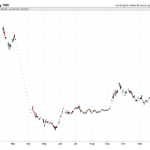Understanding the fluctuations in silver spot prices in New Zealand Dollars requires a keen eye on the dynamic global market trends. As investors and traders analyze various economic indicators and industrial demands influencing silver’s value, the corresponding charts serve as vital decision-making tools.
Delving into the specifics of silver pricing within the New Zealand Dollar context not only sheds light on market patterns but also offers a unique perspective on the broader economic landscape.
Stay tuned to uncover the nuanced trends and strategic implications that shape silver’s trajectory within New Zealand’s financial realm.
Key Takeaways
Exploring the fluctuations in silver spot prices in New Zealand Dollars involves closely monitoring the ever-changing global market trends. Investors and traders analyze various economic indicators and industrial demands that impact the value of silver, using corresponding charts as essential tools for decision-making.
Examining the specifics of silver pricing within the New Zealand Dollar context not only reveals market patterns but also provides a unique perspective on the broader economic landscape. By keeping an eye on these trends, one can gain insights into the strategic implications that shape silver’s trajectory within New Zealand’s financial realm.
Stay informed to uncover the nuanced trends and strategic implications that influence silver prices in the context of New Zealand’s financial market.
Overview of Silver Spot Price
Analyzing the silver spot price in New Zealand Dollars requires considering a complex interplay of global market dynamics and local economic factors. Various elements drive silver prices, including interest rates, currency fluctuations, inflation, and demand from investors and industries.
By comparing silver prices in New Zealand Dollars to those in other currencies, we can see how these factors influence the market. Silver is traded internationally by weight, such as ounces, grams, and kilos, and its value is impacted by diverse variables, including its applications in solar panels and electronics.
As new uses for silver emerge, the market may experience shifts in pricing trends, underscoring the importance for investors and analysts to stay abreast of these developments to make informed decisions.
Historical Silver Price Trends
Exploring the historical trends of silver prices in New Zealand Dollars sheds light on the evolution of market dynamics and the economic factors influencing the precious metal’s valuation over time.
By analyzing silver price fluctuations, market insights, and key historical events impacting silver prices, we gain a deeper understanding of how silver has responded to various economic conditions and events in New Zealand.
This analysis also allows for a comparison with global silver price trends, providing valuable insights for investors and analysts to make informed decisions regarding silver investments in the New Zealand market.
Understanding Silver Price Fluctuations
Studying the intricate patterns of silver price movements on a regular basis can offer valuable insights into the market’s volatility and the factors that underlie these fluctuations. To grasp silver price fluctuations, it is essential to delve into the dynamics of the silver market and identify the key drivers affecting silver prices.
Factors such as industrial demand, investor sentiment, geopolitical events, and macroeconomic trends play a significant role in influencing the price of silver. Industrial demand reflects the need for silver in various industrial sectors and can either drive prices up or down. Investor sentiment, which encompasses market perception and speculative trading, often leads to price volatility. Economic conditions, including GDP growth, inflation rates, and interest rates, also impact silver prices by influencing supply and demand dynamics.
Impact of Global Economic Factors
Understanding the fluctuations in silver prices offers valuable insights into how global economic factors influence the silver market’s volatility. Economic indicators and market analysis are essential for grasping the dynamics of silver pricing. Factors like interest rates, currency fluctuations, and inflation can significantly impact silver prices due to its dual role as an investment and industrial asset.
Silver’s current industrial applications in solar panels and electronics highlight its sensitivity to economic trends. With evolving demands and potential new applications, the silver market remains dynamic, shaping its future trajectory.
Analyzing Silver Price Charts
Analyzing trends in silver price charts provides valuable insights into market behavior and potential future movements. Correlations between silver prices and factors like economic indicators or geopolitical events can be revealing.
Evaluating silver price volatility helps investors gauge risk levels in silver investments. Understanding how silver prices change over time is crucial for crafting effective trading strategies and managing risks.
Systematic analysis of silver price charts allows investors to spot patterns, trends, and potential market turning points, empowering them to navigate the dynamic silver market with confidence.
Investing in Silver in NZD
Investing in silver in New Zealand Dollars can be a smart move for investors looking to diversify their portfolios with precious metals. Silver holds intrinsic value and can serve as a hedge against economic uncertainties, particularly inflation and instability. The silver market is influenced by factors such as industrial demand and global economic conditions, making it a dynamic investment option.
Adding silver to an investment portfolio can bring diversification benefits, enhancing overall risk management. One way to invest in silver is through physical assets from reputable sources like the New Zealand Mint, ensuring security and authenticity in your holdings. It’s important to stay informed about silver prices and market trends to make well-informed investment decisions.
Silver Price Forecasting Methods
Forecasting silver prices involves using sophisticated analytical models and historical data analysis to predict future price movements accurately. Analysts study past price trends, market conditions, and factors affecting supply and demand to make informed predictions. Methods such as technical analysis, fundamental analysis, and sentiment analysis play crucial roles in forecasting silver prices.
Technical analysis focuses on chart patterns and statistical indicators to predict the direction of silver prices. Fundamental analysis considers economic factors, geopolitical events, and industrial demand to determine the intrinsic value of silver. Sentiment analysis evaluates market sentiment and investor behavior to anticipate future price movements.
Comparing Silver Prices Internationally
When examining the global silver market, one can observe significant price variations across different regions. Several factors influence silver prices, including supply and demand dynamics, economic indicators, geopolitical factors, currency fluctuations, and market speculation. These elements contribute to the complexities of the market and result in diverse pricing internationally.
Discrepancies in silver prices can be attributed to various factors such as differences between physical and paper silver prices, variations in premiums charged by dealers, disparities in taxation on silver purchases, discrepancies in mining and production costs, and varied levels of investor sentiment. These differences underscore the importance of considering multiple variables when comparing silver prices across different countries. By understanding these factors, investors can make informed decisions in the ever-changing global silver market.
Frequently Asked Questions
How Does the New Zealand Mint Ensure the Quality and Purity of Its Gold and Silver Bullion Products?
The New Zealand Mint upholds the exceptional quality and purity of its gold and silver bullion products by implementing strict quality control measures and utilizing advanced manufacturing processes. Each item undergoes meticulous testing to uphold the mint’s prestigious reputation for excellence in the industry. This commitment to quality assurance ensures that customers receive bullion products of the highest standard, reflecting the mint’s dedication to producing top-tier precious metal items for investors and collectors alike.
What Are Some Unique Factors That Influence Silver Pricing Specifically in the New Zealand Market?
In the New Zealand market, silver pricing is influenced by a variety of unique factors. These include the local supply and demand dynamics, fluctuations in currency values, geopolitical events, and the overall economic conditions of the country. These elements play a significant role in determining the value of silver in New Zealand, shaping the market trends and pricing strategies. Understanding how these factors interact is crucial for investors and stakeholders looking to navigate the silver market in New Zealand effectively.
Can You Provide Examples of Recent Innovative Industrial Applications of Silver That Have Contributed to Its Demand and Pricing?
In recent years, the demand for silver has surged due to its use in cutting-edge industrial applications. One notable example is its incorporation into antimicrobial coatings for medical equipment, where silver’s unique properties help inhibit the growth of harmful bacteria, thus ensuring a safer healthcare environment. Additionally, the integration of silver in 5G technology has been pivotal for enhancing conductivity and signal transmission, making it an essential component in the development of high-speed communication networks. These innovative uses of silver have not only driven up demand but also influenced its pricing in the market, showcasing the metal’s versatility and significance in various industries.
How Does the Mining Industry in New Zealand Specifically Impact the Country’s Silver Prices and Overall Economy?
The mining industry in New Zealand plays a significant role in influencing silver prices and the overall economy of the country. Its impact is vital for economic growth, as mining activities drive production levels, boost export revenues, create employment opportunities, and attract investments in related sectors. The extraction and processing of silver in New Zealand not only contribute to the country’s wealth but also support various industries that rely on this precious metal for manufacturing and trade. The mining sector’s performance directly affects the supply and demand dynamics of silver in the market, influencing its price fluctuations and overall economic stability in New Zealand.
What Are Some Potential Future Developments or Trends in the New Zealand Silver Market That Investors Should Be Aware Of?
When considering the future of the New Zealand silver market and potential investment opportunities, it’s essential to analyze market trends and possible price fluctuations. One significant aspect to keep in mind is the evolving demand for silver driven by advancements in industrial applications and technology. These factors can play a crucial role in shaping the market landscape and influencing investment decisions. Keeping abreast of these developments can help investors make informed choices and capitalize on opportunities in the dynamic silver market.





